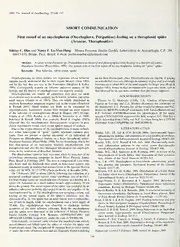
First record of an onychophoran (Onychophora, Peripatidae) feeding on a theraphosid spider (Araneae, Theraphosidae) PDF
Preview First record of an onychophoran (Onychophora, Peripatidae) feeding on a theraphosid spider (Araneae, Theraphosidae)
2009. The Journal ofArachnology 37:116-117 SHORT COMMUNICATION First record of an onychophoran (Onychophora, Peripatidae) feeding on a theraphosid spider (Araneae, Theraphosidae) Sidclay C. Dias and Nancy F. Lo-Man-Hung: Museu Paraense Emilio Goeldi, Laboratorio de Aracnologia, C.P. 399, 66017-970, Belem, Para, Brazil. E-mail: [email protected] Abstract. Avelvet\Novm(Peripatussp.,Peripatidae)wasobservedandphotographedwhilefeedingonatheraphosidspider, Hcipalopushiitantcm (Perez-Miles, 1998). The present noteis the first report ofan onyehophoran feeding on “giant” spider. Keywords; Prey behavior, velvet worm, spider Onychophorans, or velvet worms, are organisms whose behavior on the floorforests(pers. obs.). Onychophoransarecapable ofpreying remains poorly understood due to their cryptic lifestyle (New 1995) onanimalstheirownsize,althoughthequantityofglueusedinanattack and by the fact they are rare in the Neotropics (Mcglynn & Kelley increasesuptoabout 80% ofthetotalcapacityforlargerprey(Read& 1999). Consequently reports on hitherto unknown aspects of the Hughes 1987). Itmaybethatencounterswithlargerpreyitems, suchas biology and life history ofonychophorans are urgently needed. that observed by us, are morecommon than previously supposed. Onychophorans are almost all carnivores that prey on small ACKNOWLEDGMENTS invertebratessuch assnails, isopods,earthworms, termites, and other small insects (Hamer et al. 1997). They are widely distributed in Thanks to G. Machado (USP), T.A. Gardner (Universidade southern hemisphere temperate regions and in the tropics (Reinhard Federal de Lavras), and C.A. Rheims (Butantan) for comments on & Rowell 2005). Small spiders are likely to be consumed by the manuseript; F.E. Pimenta for all the wonderful photos and N.C. onychophorans. Laboratory studies have focused on some aspects Bastos for B&W PhotoShop®treatments; S.M. Lucas(Butantan)and of the behavior of onychophorans (Read & Hughes 1987; Monge- R.P. Indicatti (UFRRJ/Butantan) for identification of the spider Najera et al. 1993; Barclay et al. 2000a,b; Sunnucks et al. 2000; species; CNEC/ALCOA supported the field samples; S.C. Dias has a Reinhard & Rowell 2005). For example, Read & Hughes (1987) Ph.D. fellowship from CNPq and N.F. Lo-Man-Hung has a DTI-IE observed that the onychophoran Macroperipatiis tonpiatus in prey fellowship from CNPq/PPBio (# 384024/2006-8). choice experiments would catch ctenid spiders instead ofcrickets. Due to the cryptic lifestyle ofthe onychophorans, it seems unlikely LITERATURE CITED that either non-cryptic or “giant” spiders represent common prey Barclay, S.D., J.E. Ash & D.M. Rowell. 2000a. Environmental factors items. Here we present a chance encounter of an individual of influencingthepresenceand abundanceofa log-dwellinginvertebrate, Peripatus sp. (Onychophora) feeding on a large theraphosid spider, Eiiperipatoidesrowelli(Onychophora).JournalofZoology250:425-436. Hapalopusbiitantan(Perez-Miles, 1998).Toourknowledge, thisisthe Barclay, S.D., D.M. Rowell & J.E. Ash. 2000. Pheromonally medi- first description of an interaction between onychophorans and ated colonization patterns in the velvet worm Eiiperipatoides theraphosids and also the first biological information for onychoph- rowelli (Onychophora). Journal ofZoology 250:437^146. orans in the rainforests of Brazilian Amazon. Hamer, M.L., M.J. Samways & H. Ruhberg. 1997. A review ofthe The observations reported here were seen when we were part ofan Onychophora of South Africa, with discussion oftheir conserva- invertebrate monitoring campaign in Juruti River Plateau, Juruti, tion. Annals ofthe Natal Museum 38:283-312. Para, Brazil in February 2007. The area is comprised of terrafirme New, T.R. 1995. Onychophora in invertebrate conservation: priori- (dry land) and the fieldwork that result in behavioral reports was ties, practice and prospects. Zoological Journal of the Linnean conducted mostly in undisturbed matureforestat the Igarape Mutum Society 14:77-89. valley (02°36'10"S, 56°12'25"W) (Pinto-da-Rocha & Bonaldo 2006). McGlynn, 1T.P. & C.D. Kelley. 1999. Distribution ofa Costa Rican On 7 February 2007 at about 2200 h, following the collection ofa wet forest velvet worm (Onychophora: Peripatidae). Annals ofthe nocturnal arachnid sample (active visual searching), one of us (N.F. Entomological Society ofAmerica 92(l):53-55. Lo-Man-Hung) noted an onychophoran (Peripatus sp.) feeding on a Monge-Najera, J., Z. Barrientos & F. Aguilar. 1993. Behavior of spider (H. biitantan) on a small leafless branch approximately 50 cm Epiperipatiis biolleyi (Onycophora: Peripatidae) under laboratory abovetheground.Thedorsal region ofthespiderwasentangledbyan conditions. Revista de Biologia Tropical 41:689-696. adhesive substance probably discharged from the oral papillae ofthe Pinto-da-Rocha, R. & A.B. Bonaldo. 2006. A structured inventoryof onychophoran (Fig. 1). Theonychophoran wasgrasping,cutting, and harvestmen (Arachnida, Opiliones) at Juruti River plateau. State feeding on the ventral region of the spider’s abdomen, near the ofPara, Brazil. Revista Iberica de Aracnologia 13:155-162. spinneremtsm(Fig. 2). Thespiderwas an adult female with acephalotho- Read, V.M.St. J. & R.N. Hughes. 1987. Feeding behaviour and prey rax 22 in length, while the onychophoran had a total length of choicein Macroperipatiistorqiiatiis(Onychophora). Proceedingsof 35 mm. The onychophoran was observed to discharge further Royal Society, London B (biologieal series) 230:483-506. quantities of the same adhesive substance. Both the onychophoran Reinhard,J. & D.M. Rowell. 2005. Social behaviourin an Australian and the spider were deposited in the collection of Museu Paraense velvet worm, Eiiperipatoides rowelli (Onychophora: Peripatopsi- Emilio Goeldi, Curator A.B. Bonaldo, (MPEG(ONY)OOOl and dae). Journal ofZoology 267:1-7. MPEG(ARA)10006, respectively, under thecodeJURU005-181. Sunnucks, P., N.C. Curach, A. Young, J. French, R. Cameron, D.A. Unfortunately, we cannot verify whether the onychophoran actively Briscoe& N.N. Tait. 2000. Reproductive biologyoftheonychoph- preyed (hunted and killed) upon the spider or whether the spider was oran Eiiperipatoides rowelli. Journal ofZoology 250:447-460. found alreadydead. Thetheraphosid H. biitantan lives in rotten trunks or underthe rootsofbuttresstreesand arefrequentlyfoundwandering Manuscript received5 February 2008, revised16 August 2008. 116 DIAS & LO-MAN-HUNG—ONYCOPHORAN FEEDING ON A THERAPHOSID 117 — Figures 1,2. Onychophoran (Peripatus sp.) feeding on a theraphosid spider (Hapalopus butantcm) in a terra firme Amazonian rain forest, Juruti, Para, Brazil. 1. Spider glued to the stick by the dorsal region; 2. Onychophoran grasping and feeding on the ventral region ofthe spider near the spinnerets on the abdomen (photos by F.E. Pimenta).
